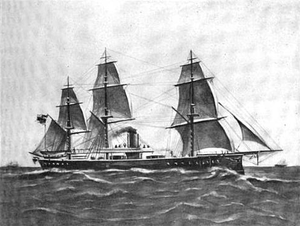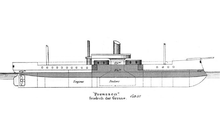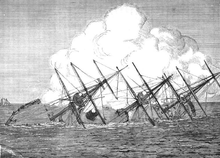Preussen-class ironclad
 SMS Grosser Kurfürst under sail before her loss | |
| Class overview | |
|---|---|
| Builders: | AG Vulcan, Kaiserliche Werft Kiel, and Kaiserliche Werft Wilhelmshaven |
| Operators: |
|
| Preceded by: | SMS König Wilhelm |
| Succeeded by: | Kaiser class |
| Built: | 1868–1878 |
| In commission: | 1876–1920 |
| Completed: | 3 |
| Lost: | 1 |
| Retired: | 2 |
| General characteristics | |
| Displacement: |
|
| Length: | 96.59 m (316 ft 11 in) |
| Beam: | 16.30 m (53 ft 6 in) |
| Draft: | 7.11 m (23 ft 4 in) |
| Installed power: | 4,998 ihp (3,727 kW) |
| Propulsion: | 1 single expansion steam engine |
| Sail plan: | Full-rigged ship |
| Speed: | 14 knots (26 km/h; 16 mph) |
| Range: | 1,690 nmi (3,130 km) at 10 kn (19 km/h) |
| Complement: |
|
| Armament: |
|
| Armor: |
|
The Preussen class of armored frigates was a class of three ships built for the German Imperial Navy in the early 1870s. The lead ship, Preussen, was laid down in 1871 and launched in 1873. Friedrich der Grosse also was laid down in 1871 and launched in 1874. Grosser Kurfürst, although the first to be laid down, in 1869, was the last to be completed, launched in 1875. The ships served in the fleet starting in 1876, when Preussen was commissioned.
Grosser Kurfürst was lost in 1878 during maneuvers shortly after her commissioning, when a pair of small sailing boats crossed the bows of Grosser Kurfürst and König Wilhelm, which caused both ships to undertake emergency maneuvers. In the confusion, König Wilhelm collided with Grosser Kurfürst, causing the latter to sink. Both Preussen and Friedrich der Grosse served in the fleet until the 1890s, when they were relegated to secondary duties, including serving as harbor ships, and later as coal hulks. The ships were eventually scrapped following the end of World War I, in 1919 and 1920, respectively.
Design
General characteristics

The ships of the Preussen class were 94.50 m (310.0 ft) long at the waterline and 96.59 meters (316.9 ft) long overall. They had a beam of 16.30 m (53.5 ft) and a draft of 7.12 m (23.4 ft) forward and 7.18 m (23.6 ft) aft. At the designed displacement, the vessels displaced 6,821 metric tons (6,713 long tons; 7,519 short tons). When the vessels were fully loaded, they displaced 7,718 t (7,596 long tons; 8,508 short tons). Their hulls were built with transverse and longitudinal iron frames; iron plating covered teak backing. The ships had twelve watertight compartments and a double bottom that ran for 60 percent of the length of the hull.[1]
The German navy regarded the ships as good sea boats, very sensitive to commands from the helm, and with a gentle motion. The ships had a tight turning radius, but crank and slow while under sail. Their standard complement consisted of 46 officers and 454 enlisted men. The ships carried a number of smaller boats, including one picket boat, two launches, one pinnace, two cutters, two yawls, and two dinghies.[2]
The three ships were powered by one 3-cylinder single expansion engine; Preussen's engine was built by AG Vulcan, while Friedrich der Grosse and Grosser Kurfürst were equipped with engines manufactured by F A Egells of Berlin. The ships' engines drove a single four-bladed screw that was 6.60 m (21.7 ft) in diameter. The engines were supplied with steam by six coal-fired transverse trunk boilers, which were provided by the Imperial Dockyard in Wilhelmshaven. The six boilers were trunked into a single large, retractable funnel amidships. She was also equipped with a full ship rig. Three generators provided 30 kilowatts of electrical power.[3] The ships' top speed was 14 knots (26 km/h; 16 mph), at 5,471 indicated horsepower (4,080 kW). The ships were capable of storing 564 t (555 long tons; 622 short tons) of coal; this enabled the ships to steam for 1,690 nautical miles (3,130 km; 1,940 mi) at a cruising speed of 10 knots (19 km/h; 12 mph).[1]
Armament and armor
The Preussen class ships were armed with four 26 cm (10 in) L/22 guns mounted in a pair of gun turrets placed amidships. These guns were supplied with 400 rounds of ammunition. They could depress to −3° and elevate to 11°; this enabled a maximum range of 5,000 m (16,000 ft). As built, the ships were also equipped with two 17 cm (6.7 in) L/25 guns. Two hundred rounds of ammunition were supplied to these guns. As with the 26 cm guns, the 17 cm weapons could elevate to 11° for a maximum range of 5,000 m. Between 1889–1891, Preussen and Friedrich der Grosse were rebuilt and their armament was significantly augmented. Six and later ten 8.8 cm (3.5 in) SK L/30 quick-firing guns were installed, supplied with up to 2,500 rounds of ammunition. Two auto-cannons were added as well. Both ships also had five 35 cm (14 in) torpedo tubes added: Preussen's tubes were installed in the hull, underwater, while Friedrich der Grosse's tubes were placed above water. Both ships had a stock of 13 torpedoes.[2]
The ships' armor was made of wrought iron and backed with teak. The armored belt was arrayed in two strakes. The upper strake was 203 mm (8.0 in) thick; the lower strake ranged in thickness from 102 to 229 mm (4.0 to 9.0 in). Both were backed with 234 to 260 mm (9.2 to 10.2 in) of teak. Their forward conning towers were protected with 30 mm (1.2 in) thick sides and 50 mm (2.0 in) thick slopes. The gun turrets had 25 mm (0.98 in) thick roofs and sloped sides varying in thickness between 203 to 254 mm (8.0 to 10.0 in) backed with 260 mm (10 in) thick teak.[1]
Construction
_b_715.jpg)
The design for this class of ironclads was prepared in 1868 by the Admiralitätsrat Elbertzhagen.[1] The original design was for a warship with a main battery mounted in a central battery, and Grosser Kurfürst was laid down as such. In the course of 1869, the design was revised and the main battery was redesigned and two twin gun turrets replaced the central battery. The reworking of the design caused significant delays in construction of Grosser Kurfürst.[4] The ship was launched on 17 September 1875, the last vessel of the class to be completed.[2] The ship was built by the Imperial Dockyard in Wilhelmshaven, while her sisters, Preussen and Friedrich der Grosse, were built by AG Vulcan in Stettin and the Imperial Dockyard in Kiel, respectively.[1]
Preussen and Friedrich der Grosse, which were laid down in 1870 and 1869, respectively, were completed much more quickly than Grosser Kurfürst.[4] Preussen was launched on 22 November 1873, while Friedrich der Grosse was launched on 20 September 1874. The former was completed by July 1876 and commissioned into the fleet on 4 July, and the latter joined the fleet 22 November 1877.[3] Preussen's construction process, six years long, was much shorter than either of her sisters; Friedrich der Grosse required eight years to complete, while work Grosser Kurfürst lasted for a decade. The delays associated with redesigning Grosser Kurfürst contributed to the significantly longer construction process, though this was compounded by the shipbuilders assigned to each ship. Grosser Kurfürst and Friedrich der Grosse were built by recently created Imperial shipyards, while Preussen was built by an established dockyard.[4]
Service history
After her commissioning in July 1876, Preussen served with the fleet.[2] She joined a squadron sent to the Mediterranean Sea in 1877 in response to unrest in the Ottoman Empire related to the Russo-Turkish War; the violence threatened German citizens living there. The squadron, under the command of Rear Admiral Carl Ferdinand Batsch, steamed to the ports of Haifa and Jaffa in July 1877, but found no significant tensions ashore. Batsch then departed and cruised the Mediterranean for the remainder of the summer, returning to Germany in October.[5]

By May 1878, all three Preussen-class ships were ready for the annual summer maneuvers of the armored squadron. The three ships were joined by the large armored frigate König Wilhelm, and operated under the command of Rear Admiral Batsch. Friedrich der Grosse missed the maneuvers after running aground off Nyborg, leaving Batsch just three vessels. While steaming in the English Channel on 31 May, König Wilhelm accidentally rammed Grosser Kurfürst;[6] the latter quickly sank with the loss of between 269 and 276 men.[lower-alpha 1] Her loss spurred a series of investigations into the circumstances of the collision, which ultimately resulted in the acquittal of both Rear Admiral Carl Ferdinand Batsch, the squadron commander, and Count Alexander von Monts, the captain of Grosser Kurfürst. Political infighting over the affair led to ouster of Rear Admiral Reinhold von Werner from the navy.[7]
Preussen and Friedrich der Grosse remained in the armored squadron for the training cruises starting in 1879 through 1883, when they were put into reserve and replaced by newer vessels, including the four Sachsen-class ironclads.[8] The two ships were reactivated in 1889 to participate in cruises following the coronation of Kaiser Wilhelm II. These included a state visit to Great Britain in August 1889 and a tour of the Mediterranean in the winter of 1889–1890.[9] The two ships resumed their duties in the training cycles into the early 1890s. Although Preussen was withdrawn from active service in 1891, Friedrich der Grosse continued to serve until the end of 1894.[10] Upon leaving active duty, both ships were used in secondary roles as harbor ships and later as coal hulks for torpedo boats. They were both ultimately sold for scrapping in 1919 following the end of World War I. Both vessels were broken up by 1920.[2]
Footnotes
Notes
Citations
References
- Gardiner, Robert, ed. (1979). Conway's All the World's Fighting Ships 1860–1905. Greenwich, UK: Conway Maritime Press. ISBN 978-0-8317-0302-8.
- Gröner, Erich (1990). German Warships: 1815–1945. Annapolis: Naval Institute Press. ISBN 978-0-87021-790-6. OCLC 22101769.
- Sondhaus, Lawrence (1997). Preparing for Weltpolitik: German Sea Power Before the Tirpitz Era. Annapolis: Naval Institute Press. ISBN 978-1-55750-745-7.